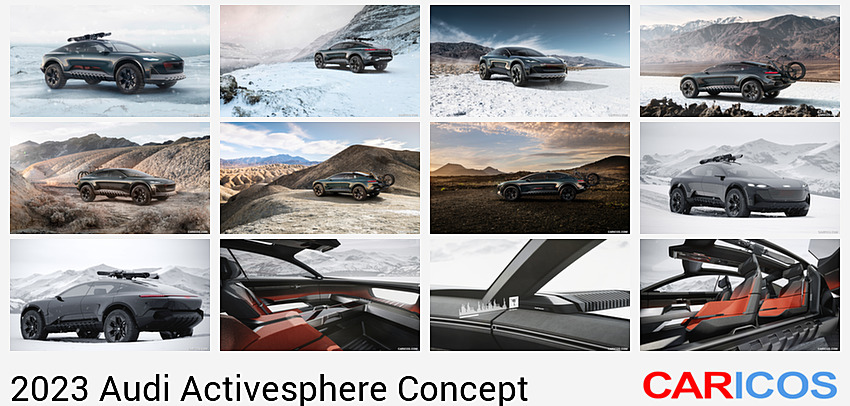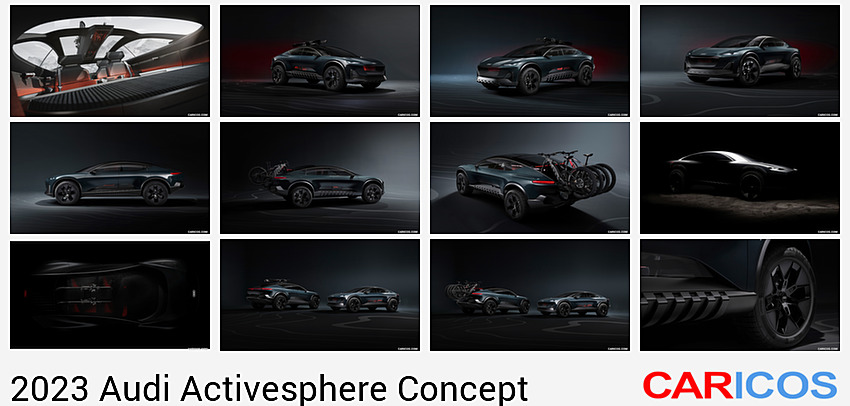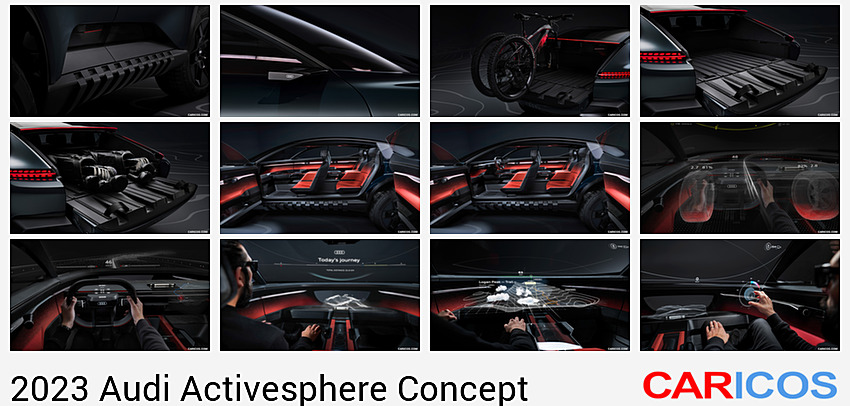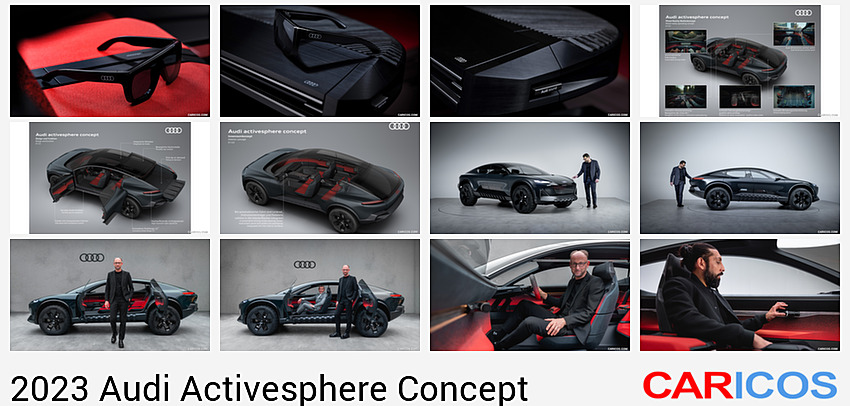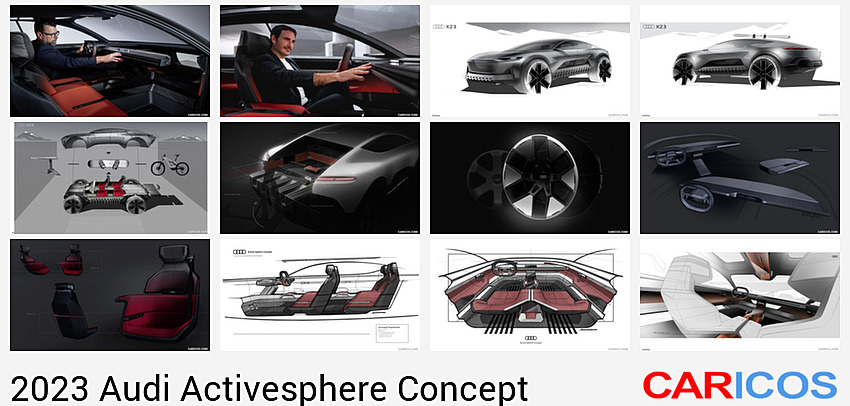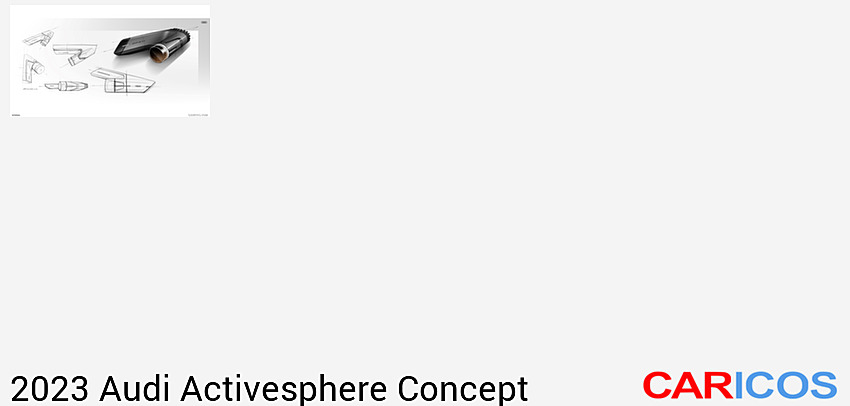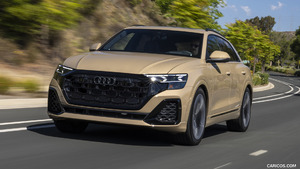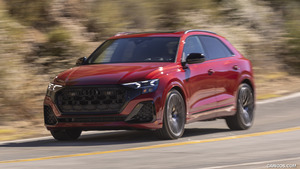Audi Activesphere Concept
- Audi presents crossover study with electric drive and quattro
- A luxury coupé that turns into a pickup
- Innovative operating concept with augmented reality headsets
As the fourth model in the series, the Audi activesphere concept marks the culmination of sphere concept vehicles brought forth by the brand with the four rings. Following on from the Audi skysphere roadster in 2021, and both the Audi grandsphere sedan, and the Audi urbansphere space concept in April 2022, a four-door crossover coupé with an astonishingly versatile body design is now making its debut. Standing 4.98 meters long, the highly elegant car is more than a mere luxury-class sports car, with impressive ground clearance, and large 22-inch wheels announcing its off-road talent. The Sportback rear of the activesphere can turn into an open cargo bed (“active back”) at the touch of a button – perfect for carrying recreational equipment such as e-bikes or water and winter sports gear.
By combining opposites in perfect synthesis, the Audi activesphere proves to be a versatile crosser of boundaries, with a drive system and suspension which make it equally adept on both on and off the road. The steering wheel and pedals allow the driver to actively control the car, while also offering autonomous driving for a more relaxed time on the road. As a coupé that is as elegant as it is dynamic, it features classic proportions and lines, but in just a few seconds, the car transforms into a pickup for transporting top-class sports gear – there is even enough space for two e-bikes in the cargo bed.
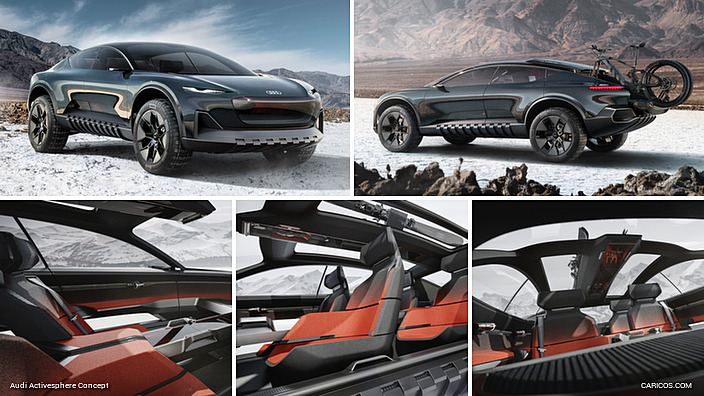 2023 Audi Activesphere Concept
2023 Audi Activesphere Concept
The concept car was conceived and designed at the Audi Design Studio in Malibu, just a stone’s throw away from the Pacific Coast Highway, the legendary coastal road. Studio manager Gael Buzyn and his team are the creative minds behind the project. He describes the idea behind the project: “The activesphere is unique. It is a new type of crossover that cleverly combines the elegance of an Audi Sportback, the practicality of a SUV and true offroad capabilities.”
With an electric drive and quick-charging technology from Audi’s PPE modular system, the Audi activesphere joins the sphere family of concept vehicles. With no local emissions, a range of over 600 km, and extremely fast charging times thanks to 800-volt technology, it combines the sustainability, dynamics and long-distance capability of state-of-the-art electric vehicles.
Oliver Hoffmann, Member of the Board of Management for Technical Development: “The sphere concept vehicles show our vision for the premium mobility of the future. We are experiencing a paradigm shift, especially in the interior of our future Audi models. The interior becomes a place where the passengers feel at home and can connect to the world outside at the same time. The most important technical innovation in the Audi activesphere is our adaptation of augmented reality for mobility. Audi dimensions creates the perfect synthesis between the surroundings and digital reality.”
The autonomous chauffeuring capability on suitable terrain gives drivers and passengers a new level of freedom, which, thanks to the new display and operating technology, can be used in the activesphere in a variety of ways. The innovative operating concept, Audi dimensions, combines the physical and virtual worlds (i.e., mixed reality) by displaying digital content in the occupants’ fields of vision in real time.
High-tech headsets provide a view of the real environment and the route, while simultaneously displaying 3D content and interactive elements– individually configurable for drivers and passengers.
This means all driver-relevant information, such as driving status and navigation, can be displayed. And in the interior, headset users can see control panels and other virtual displays in a tidy, minimalist design that remains hidden to the unaided eye. Mixed reality optics gives users the ability to interact precisely with these real, yet invisible, touch-sensitive zones, as the headsets display and carry out functions by reacting in real time when users touch them.
As a perfect all-rounder, the Audi activesphere concept is ideally suited for the high demands of a future-oriented generation of Audi customers – people for whom individual mobility and sustainability are not mutually exclusive. Also, owners who expect their vehicle to deliver the brand’s typical aesthetics and dynamism in the highest degree, combined with future-oriented technology. For these customers, the Audi activesphere concept acts as a fascinating vision of crossing the boundaries between these dimensions.
Robust elegance – exterior design
Its dimensions – 4.98 meters long, 2.07 meters wide, and 1.60 meters high – make the Audi activesphere concept a member of the premium segment. Typical of an electric car, the wheelbase is a generous 2.97 meters, providing maximum legroom for passengers. The front and rear overhangs are correspondingly short for a much more compact impression than the mere numbers indicate. From all perspectives, the Audi activesphere concept appears monolithic, as if from a single mold.
Large 22-inch wheels and striking ground clearance, the flat cabin so typical of an Audi, and a dynamic roof arch give the car proportions that are distinctly reminiscent of a sports car.
The 285/55 tires are voluminous enough for all types of terrain, and their contoured tread highlights the activesphere’s talent for off-road use. The wheels feature movable segments: when used off-road, they open for optimum ventilation, and they close on-road for optimum aerodynamics. The elegant, stylish camera mirrors on the two front doors are also designed specifically to minimize drag.
The absence of hard edges results in smooth transitions between convex and concave surfaces throughout the body, as well as in soft shadows. Viewed from the side and rear, the rear wheel wells appear markedly horizontal, visualizing the dynamic potential of the concept vehicle.
Glass surfaces make up a significant part of the vehicle’s body – and by no means just at head height. The front end of the activesphere features the brand face, the Singleframe, designed as a transparent glazing to afford passengers an unobstructed view through the large frunk of the road in front of the vehicle.
There are also glass surfaces on the side in the lower door area, which seem to dissolve the boundary between the natural world and the interior when the activesphere is in off-road mode. The wide, curved tailgate features extensive glazing for optimum lighting, whilst even the roof itself is transparent, letting plenty of daylight into the interior.
The exterior look specifically signals the vehicle’s off-road capability and, with its voluminous wheel arches, portrays the variable, electronically controlled quattro all-wheel drive. The Audi activesphere’s ground clearance is also variable; ideal for off-road use, it can be increased by 40 millimeters from the basic height of 208 millimeters, or lowered by the same amount when driving on-road. This benefits both the center of gravity and aerodynamics when driving fast. The approach angle of the Audi activesphere – relevant for off-road drives – is 18.9 degrees, the departure angle 28.1 degrees.
The variable ground clearance is reminiscent of an Audi model family that has attracted an enthusiastic, loyal fan base in the C and later B segments since 2000 – the Audi allroad. From the first generation, this family also features air-spring suspension with variable ground clearance and a visually offset floor assembly with underride guard elements as a significant design feature. Equally significant for all allroad models is the Avant package option.
The activesphere marks the first time that a car with a Sportback hatchback incorporates the design elements and technical equipment of an allroad. For this reason, Audi calls the new body variant “active Sportback” in contrast to the allroad.
Another new variation of the allroad theme – the Audi activesphere concept features dark, high-gloss paint finishes in Arctic Teal on the front and rear as well as underneath the doors in the side area, plus matte surfaces that visually juxtapose the floor assembly and cabin. Metal strips with slightly offset vertical studs, arranged parallel to one another, are integrated here. These elements deploy when the ground clearance is increased, visualizing the off-road mode.
As with its relative, the Audi grandsphere concept, the doors of the Audi activesphere, which are attached to the A- and C-pillars at the front and rear, open in opposite directions; there is no B-pillar here either. This innovation means the entire interior space opens up to passengers as soon as they get into the car.
Right and left above the Singleframe, the narrow headlight units appear like focused eyes. The lighting units echo the logo of the brand with the four rings by enlarging and isolating the intersection of two rings to form a pupil – a new, unmistakable digital light signature that Audi first introduced in the Audi grandsphere: the Audi eye. In the activesphere, this signature is now varied – on-road and off-road driving modes each have their own variant. Daytime running lights and rear lights use ultra-fine micro-LED technology for even greater precision and contrast.
Sportback and active back – variable rear architecture
The Audi activesphere concept is a crosser of boundaries, which means it is a master of metamorphosis. Its rear section in particular reflects the active lifestyle of its customers and makes it possible to transport even bulky sports gear– without sacrificing the elegance and sportiness of the Sportback silhouette.
If required, the transparent rear window slides are almost flush with the roof of the Audi activesphere. At the same time, the lower, vertical segment of the rear folds horizontally – this opens up an ample cargo bed called the active back that features brackets for e-bikes, for example. The lateral surfaces of the rear, the C-pillars, remain in position to maintain the activesphere’s dynamic silhouette, whilst a motorized bulkhead deploys from behind the rear seats in order to isolate the cabine from the elements.
A ski rack is integrated in the center of the roof structure. Completely flush in nominal position and practically invisibly in the roof arch, it extends if required, so that skis can be safely attached and transported.
Prioritized interior – people-focused
“Sphere” sets the tone: the common name component of the Audi skysphere, grandsphere, urbansphere, and now also the activesphere, alludes to the interior. Kilowatts and km/h or lateral acceleration are no longer at the top of the design specifications for this new generation of cars. Instead, the starting point is the interior, the occupants’ living and experience sphere whilst traveling. Their needs and desires shape the space, the architecture, and the functions.
With that reassessment, the design process itself changes. At the beginning of all discussions, the focus is directed toward the interior and its design. Only then are the package, proportions, and lines of the exterior designed.
Functional and minimalist – the interior
The epitome of clarity and tidiness – this is the first impression for passengers as they climb into the interior of the Audi activesphere through the wide-open doors.
Vertical and horizontal surfaces, along with right angles dominate the architecture of the space. The interior zones feature horizontal contrasting coloring and the reigning centerpiece is the seating surfaces and door and front paneling in warm lava red, which contrast with the dark exterior even when looking through the side windows. Above and below this central zone, dark colors (black, anthracite, and dark gray) also dominate.
The four individual seats are suspended like extensions of the high, full-length center console. Resting on the center console, the upper end of the seat shell’s inner side is shaped horizontally as an armrest. The designers imagined the seat, back, and shoulder surfaces as three separate, circumferential shells; the visual appearance alone already promises good lateral support. They also appear so light as to float and thus maintain the balance between automotive function and the elegance of a lounge chair.
When the Audi activesphere concept is driving in autonomous mode, the dashboard, steering wheel, and pedals disappear into an invisible position. Especially in the first row of seats, a wide space opens in front of the driver, which extends to the front end of the activesphere – and beyond. For a clear field of vision, the fully glazed Singleframe gives passengers an unobstructed view of the road in front.
The dashboard itself works like a xlarge soundbar (through the wood lammels) as well as a smart, full width airvent in both the deployed and stowed position.
If the driver wants to take over the wheel, the dashboard, along with the steering wheel, swivels out from its flush position below the windshield – each driver can adjust the ideal ergonomic position individually. The MMI touchless controls in the doors are always accessible to the eye and the hand,for example to control windows and seat adjustments.
The architecture and sense of space in the Audi activesphere are largely determined by the high, full-length center console. Of course, in electric cars the console is no longer needed to hold a cardan shaft, but instead offers space for storage and an on-board bar – either cooled or heated. The top cover is transparent, which provides a view of the bottle and glasses, but also visually integrates the voluminous console in the interior. Additionally, there is a console in the roof, directly above the center console and reflecting its dimensions, where the four AR headsets for the mixed reality system are kept within easy reach for all passengers.
Audi dimensions – traversing worlds
Crossing boundaries is the strength of the Audi activesphere concept – and this also applies to the interface between the car, the user, and the environment. For the first time, the new system combines physical reality and the digital sphere to create a new world: the Audi dimensions.
The centerpiece of the new system is innovative mixed reality headsets – available individually for each driver and passenger. Users also have access to a comprehensive digital ecosystem while they’re in the Audi activesphere.
In the early days, VR goggles were limited to depicting a virtual reality without any real-world elements. However, technology evolved into augmented reality, whereby the real world is superimposed with virtual content. Mixed reality is now able to depict virtual content with spatial reference to the real world in three dimensions. There’s no doubt about it: in the future, mixed reality will take the possibilities of AR head-up displays to a whole new level in terms of flexibility, precision, and displayable content.
The Audi activesphere concept is the first to use a pioneering generation of this technology, which in turn adds the dimension of interaction to the dimension of superimposed real and digital worlds. With unprecedented optical precision, highest resolution, and excellent contrast, the system brings control surfaces and displays, invisible to the unaided eye, into the user’s field of vision while behind the steering wheel.
In other words, the user can view virtual content, which is initially for information only. If the user focuses with his or her eyes on the information, thus signaling interest, the system displays more detailed information. Content becomes an active and interactive element as soon as the user is focused and engages, i.e., with gestures.
The hand can then intuitively follow the user’s gaze to control car functions, while the user interface (the virtual display in the headset) reacts to changes in real time like a conventional instrument. A particularly user-friendly feature, the virtual control moves towards the user so that he or she can interact comfortably with the user interface, regardless of sitting position.
The tidy, spacious interior of the Audi activesphere no longer has to take a back seat to the function of keyboards and scale batteries, as was always the case in classic car cockpits. Only when users need an element does it appear, and it can be operated just as intuitively as it would in the real world. Important: The diverse functions of the car are now not organized in the typical way they are today in a car with screens and physical function. But they are instead located logically directly in front of the elements they are related to. Just two examples: the AC control hoovers in front of the airvent, the entertainment and sound interactive panel hoovers over the speaker.
However, the possibilities of this technology are by no means exhausted. In off-road mode, for example, high-resolution 3D topography graphics can be projected onto the real landscape and information on navigation and the destination can be displayed. Traffic safety information, i.e., alerts for traffic jams or slippery roads, can also be used here.
Depending on their needs and tasks, passengers and drivers are provided with very individual content in their respective mixed reality headset. With the driver concentrating on steering while active behind the wheel, passengers can begin looking into and even preparing activities at the destination.
Yet, at the same time they can also control the temperature and air supply for their seating area with the air conditioning, as well as browse the music selection of the sound system, which each occupant can use individually. Because the headsets are precisely designed to match the geometry of the activesphere interior, they can even project virtual index cards onto the center console to visualize access to web content. Since the sensors of the mixed reality headsets measure the interior with millimeter precision, virtual content can be superimposed according to personal requirements and even used for individual interaction.
The connection between the headset users and the car, along with its ecosystem, offers countless possibilities, even when outside the car. For example, while navigation routes or vehicle maintenance can be prepared today from your living room on a laptop or tablet, in the future mixed reality technology and the headset will be the only hardware required.
Conversely, the activesphere passenger can take his or her headset out of the car and onto the ski slope to help navigate the bike trail or to find the ideal descent when skiing downhill.
Information about the car itself, the battery range, and the nearest charging stations can also be accessed inside and outside the vehicle. And when needed, there are also advance warnings such as of low tire pressure as well as a weather forecast function as a criterion for selecting a route.
PPE – customized drive technology
Due to its dimensions and performance level, the Audi activesphere concept lends itself to the use of Audi’s most innovative electric drive system: the Premium Platform Electric, or PPE for short.
Like the related Audi grandsphere and Audi urbansphere concept cars, the activesphere concept draws on this modular system for series production. It is being developed under Audi’s leadership together with Porsche AG – the first Audi production vehicles based on PPE will be presented, one after the other, before the end of 2023.
The PPE is designed exclusively for battery-electric drive systems and can therefore take full advantage of all the benefits of this technology – for the betterment of the cars’ driving characteristics, economy, and package options.
As a result, Audi can effectively expand the range of electric vehicles in its portfolio via the high-volume B- and C-segments. In addition, economies of scale will allow luxury-class technology and various different model versions to be incorporated into a wide-ranging lineup of models unrivaled in the premium market.
The PPE is the first platform designed to accommodate an unprecedented range of high-volume automobiles – including SUVs and CUVs with high ground clearance as well as cars with a flat silhouette that are part of Audi’s core product range, such as the Audi A6 series, whose external dimensions and wheelbase are almost identical to the Audi activesphere concept.
The key element of the future PPE fleet is a battery module between the axles; in the Audi activesphere concept, it holds around 100 kWh of energy. Using the entire car width between the axles makes it possible to achieve a relatively flat layout for the battery.
Electric motors on the front and rear axles of the all-wheel drive Audi activesphere concept together deliver a total output of 325 kW and a system torque of 720 Newton meters. The front and rear wheels are connected via a five-link axle. The concept car features Audi adaptive air suspension with adaptive dampers.
Fast charging with 800 volts
The heart of the drive technology in all future PPE models will be the 800-volt charging technology. This ensures that the battery, like the one in the Audi e-tron GT quattro before it, can be charged with up to 270 kW in a very short time at fast-charging stations. This revolutionary technology will enter the high-volume mid-range and luxury segments with the PPE for the very first time.
The PPE technology enables charging times that come close to a conventional refueling stop for a combustion engine car. Just 10 minutes is sufficient time to take enough energy on board to power the car for more than 300 kilometers.
And in less than 25 minutes, the 100 kWh battery charges from 5 to 80 percent. Together with its range of well over 600 kilometers, the Audi activesphere thus positions itself as unconditionally suitable for long distances, when need be.

